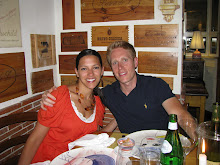
Anyway, I was browsing around Basilicata, which next to Molise is the least recognized italian region in my opinion. It's the arch of the foot on the boot that is Italy, surrounded by Calabria to the west, Campania to the north and Puglia east. It's got a very low population density and was historically poor, at least since after the days when it was a part of the Magna Grecia. No major modern cities to speak of, and that's what fascinates me.
Basilicata's cuisine reminds me a lot of Calabrian cuisine; extremely simple, a penchant for hot pepper, lots of pork and local cheeses, dried pasta as a staple. This is the type of place where people improvised, often lacking the milled and softened white flours that we take for granted. Buckwheat, unhulled wheat, burnt wheat, semola, chickpea flour all comprise the grain repetoire you'll find throughout Italy, used for centuries by commoners to make meals.
 So I got inspired to use on of my staples, chickpea flour, to fashion my interpretation of mischigli and what would be a recognizeable sauce in Basiliacata. I went back to my pasta making roots, recalling the first pasta I ever learned to make during my time in Italy, cecaluccoli.
So I got inspired to use on of my staples, chickpea flour, to fashion my interpretation of mischigli and what would be a recognizeable sauce in Basiliacata. I went back to my pasta making roots, recalling the first pasta I ever learned to make during my time in Italy, cecaluccoli. Snowed in to the irpinian mountains a couple hours east of Naples for two months during the frosty winter in 2005, I would spend a slow lunch service once a week hand crafting this cavatelli clone at the restaurant where I interned. Aside from its name, another curious thing about it is that we'd boil the water before mixing it with the flour to make the dough. Made for a tender pasta. Hours would go by and bags and bags of it would be flash frozen, after I'd shaped it, for later use.
The Mischigli of Basilicata resemble Ceccaluccoli, sort of crude Cavatelli.
The sauce is comprised of bell peppers, hot pepper, garlic and onion with ricotta salata to garnish. The traditional cheese would be cacioricotta, which is a blend of cheese and the byproduct ricotta that produces something similar to the ricotta salata I used. I opted to employ only green peppers because I want that distinct fresh pepper flavor but not all the sweetness of more mature peppers. Besides, the onions bring plenty of sugar.

Ingredients:
Pasta Dough:
2 cups chickpea flour
1 to 1 1/4 cups water
Sauce:
4 green bell peppers, cut into strips about 2 inches long, 1/2 inch wide
2 cloves garlic, minced
2 medium onions, sliced 1/2 inch thick
1 jalapeno or other hot pepper, minced
Salt and pepper to taste
Extra Virgin Olive Oil
Cacioricotta or Ricotta salata for garnish
Mix the flours in a bowl or on a board, then add the water gradually (try boiling it first if you want), starting with 1 cup and stir with a wooden spoon to bring it together into a loose ball. If it feels really dry add water bit by bit. Once the spoon stops being useful begin using your hands and fingers to work the mass into a more cohesive ball. Then turn it out onto a board and begin kneading, letting it rest periodically if need be, until you've achieved a smooth ball. Wrap it in plastic and let it rest 30 minutes.
 |
| Cut off a piece from the ball and roll back and forth while moving hands away from each other |
 |
| Cut and keep rolling until you get snakes like these |
 |
| Cut them incrementally to about 1 inch pellets |
| Press down almost through the dough and roll toward you at the same time |
| Complete the roll so that the leading edge turns up |
| Now you'll have that signature channel running through the "mischiglio" |
Cook the pasta for 5-6 minutes, tasting it once it floats for doneness. Drain and mix in the pan with the vegetables. Garnish with some oilve oil and ricotta salata and serve.

















